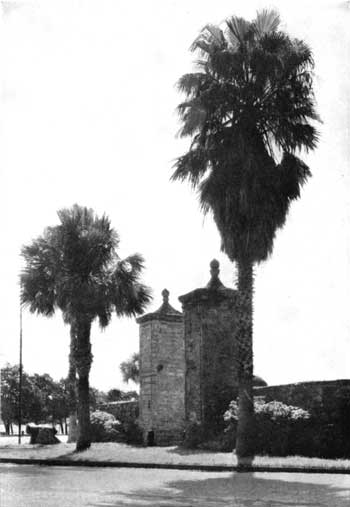MENU
|
Glimpses of Historical Areas East of the Mississippi River INTRODUCTION |

Old City Gates of St. Augustine, Fort Marion
National Monument.
(Photo by Rinehart)
A NATIONAL PROGRAM for the protection of historic sites and buildings has been gradually developed in recent years with the realization that more active participation by the Federal Government is necessary in order to prevent deterioration and destruction of the remaining physical evidences of our historic background, as well as to encourage and stimulate the efforts of private and public groups in this field. As a result of this sentiment the National Park Service in 1931 added to its national park and monument activities a program of preservation and interpretation of historic sites of national significance. In the spring of 1933 the Emergency Conservation Work Program made labor, materials, and increased technical supervision available for the task of careful development of the values of such sites. In the same year the historical reservations of various governmental agencies were consolidated in the Department of the Interior and placed under the jurisdiction of the National Park Service.
The primary purpose of the National Park Service in this field is the preservation of sites of national significance and the graphic presentation of their historical meaning through the medium of lectures, museums, and models in close proximity to the actual sites. The study of documentary materials in the case of many historical events, notably military movements, does not give the entire story. A complementary study of the sites involved is necessary for a more nearly complete understanding of the reasons for certain sequences of events. The personalities of historic figures, the flavor of a period, or the tides of battle are sensed most fully in the atmosphere of their physical background and associations.
In the more important reservations a program of educational service to the public has been established with competent historians in charge. In some areas guide service is available. In others self-explanatory maps and literature are furnished. Models and relief maps of areas as they were at certain important periods give further aid in visualizing the events which they portray. Restored houses and grounds and existing military works, carefully marked, are outdoor museums on a life-size scale. Several of the military parks have valuable museum displays of the objects of material culture and warfare related to their history. The historical and archeological materials in the different areas are available locally for the use of students.
In line with its policy in the system of scenic national parks under its jurisdiction, the National Park Service is not neglecting the recreational features of the historical reservations. Motor roads, trails for hikers, and bridle paths are making accessible points of both historical and scenic interest. Camp sites and picnic grounds are being developed in suitable areas.
The National Park Service presents this booklet on the eastern historical reservations under its jurisdiction in order to acquaint the American people with the location and historical significance of these areas, to the end that every advantage may be taken of the educational, inspirational, and recreational benefits which are to be derived from them.
 Top
Top
Last Modified: Thurs, Nov 23 2000 10:00:00 pm PDT
http://www.cr.nps.gov/history/online_books/glimpses3/glimpses0.htm
![]()
